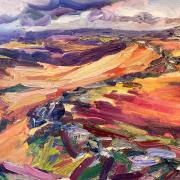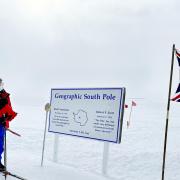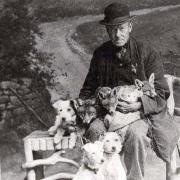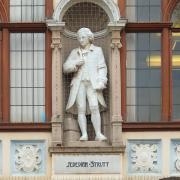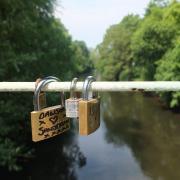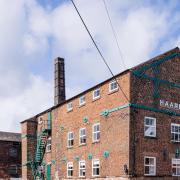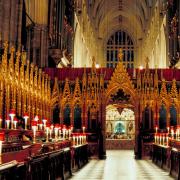Martyn Baguley remembers William Mudge (1762-1820), one of the founding figures of the Ordnance Survey, on the 200th anniversary of his death.

Two hundred years ago, on 16th April 1820, William Mudge died. Not a name that resonates like those of some of his contemporaries – Byron, Wordsworth, Darwin – but one that should be better known.
Since 1518 map-making in Britain had been a minor responsibility of the ‘Board of Ordnance’ (from the French word ordonnance which relates to the organisation of military affairs). Distinct from the army, it was an independent military body which operated from the Tower of London where a talented small band of military and civilian draughtsmen, some as young as eleven, busied themselves with the intricacies of military surveying, trigonometry and geometry, all fundamental for map-making.
Following the Jacobite rebellion in 1745, so that military maps could be made to ‘facilitate the subjugation of the clans’, a survey of Scotland using simple techniques had been done by William Roy, a young land surveyor. With a French invasion threatening, in 1756 Roy was part of a small team commissioned to prepare rough maps of England’s south coast. He consistently argued the case for a national survey of Britain, but his appeals fell on deaf ears.
Towards the end of the 18th century, growing concern about the prospect of a French invasion of England focussed the minds of politicians on the fact that available maps of the south coast were inadequate. They didn’t provide details of features that could hide soldiers, where troops could be quartered or the nature of terrain over which they might have to fight. With national security at stake the need for a countrywide survey to produce detailed, accurate maps had become urgent. It was clearly a job for the Board of Ordnance. By July 1791 King George III had given his approval for the survey. William Roy had died in 1790: the skills of the Board of Ordnance map-makers were going to be much in demand. Amongst them was 28-year-old Lieutenant William Mudge, a man who was to play a seminal role in the United Kingdom’s map-making history.

To get to know the man we must regress to 1st December 1762 when he was born in Plymouth. At a time when social contacts mattered, William was fortunate to be born into what is on record as being ‘an extraordinary conglomeration of high achievers with a wide variety of interests, temperaments and friends.’
Little is known about William’s early schooling, but he must have done well academically because when he was only 15 years old he was accepted into the prestigious Royal Military Academy, Woolwich, to train as a commissioned army officer. Graduating two years later with the rank of second lieutenant in the Royal Artillery, he was posted to South Carolina to join the British army fighting in the American War of Independence. He returned to England in 1783 and was stationed at the Tower of London where he was given the opportunity to study higher mathematics and amused himself in his spare time by constructing clocks.
With his good social contacts and considerable mathematical talent it is not surprising that in July 1791 William was appointed Deputy Director of the survey to serve under Major Edward Williams.
The soldier becomes a surveyor
Land surveying methods had progressed considerably following the invention in 1787 of the first theodolite, an instrument used to measure horizontal and vertical angles. In 1784 William Roy had been commissioned by the Royal Society to work with French surveyors to solve the dispute over the relative positions of the Royal Observatories of Greenwich and Paris. The work had involved the accurate measurement of the length of a baseline on the level ground of Hounslow Heath (now occupied by Heathrow Airport) followed by ‘triangulation’, a method for finding the position of a feature in the countryside by forming triangles from known points. Roy’s survey data provided a useful start for the British Survey.
Wasting no time, with the additional support of Isaac Dalby, another mathematician and surveyor who had worked with Roy on the Greenwich/Paris survey, and a small team of young artillery men, during July 1791 Williams and Mudge started carefully re-measuring the 5.2-mile-long Hounslow baseline. It took 11 weeks and finally identified an over-measurement of only 4.6 inches.
The triangulation began in the spring of 1792: it was work for young men. Regardless of the weather they had to haul the 18th century theodolite, weighing 90 kilos, on a sprung horse-drawn cart along often mud-choked roads and at every observation point winch it by crane to the top of a 30-foot-high wooden tower then, when possible, accurately read angles of sight to distant landmarks.
The surveyors sent all the measurement data in stages to the Tower of London where draughtsmen converted them into maps. By 1799 the area from the south coast north to Coventry and west to Gloucestershire had been surveyed. On 1st January 1801 the first map – an ‘Entirely New & Accurate Survey of the County of Kent’ – was published at a scale of one-inch-to-the-mile. An Austrian general pronounced it ‘the finest piece of topography in Europe.’ A second map, of Essex, was published in 1805 and a third, of Devon, was published in 1809.
Mudge makes his mark
William was appointed Director of the survey in 1798 after the death of Edward Williams. Added to the increased responsibilities were family worries. In the late 1780s he had married Jane Williamson, the daughter of a superior officer, and by 1800 they had five children. With William’s work keeping him away from London for much of the year his family had lived in Devon, so the doting father had seen little of them. All this conspired to affect his health: his normally kindly disposition and the quiet humour that had made him popular began to be affected by ‘depression of spirits’.
The work was relentless. In 1802, recognising that he needed extra help, William recruited a wiry 17-year-old Thomas Colby into the surveying team. Despite suffering a tragic accident in 1803, which resulted in his left hand having to be amputated, Thomas proved to be a huge asset, assisting William with surveys as they extended into northern England, Wales and Scotland as far north as Orkney and Shetland.
William’s work didn’t go unnoticed by his peers. In 1798 he was elected a Fellow of the Royal Society, in 1809 he was appointed Lieutenant-Governor of his alma mater, the Royal Military Academy at Woolwich, in 1813 promoted to the rank of Regimental Colonel and in 1817 awarded an honorary doctorate by the University of Edinburgh.
With the recruitment of Thomas Colby to the field surveying team William was able to spend more time in London. For the first time in his life this gave him an opportunity to buy a house. It took him three years to find a suitable place but in 1808 he bought one near to Oxford Circus and settled his wife and children in it. It was to here that he retreated in March 1820, severely unwell with ‘internal inflammation’, and died at the relatively young age of 58.
And the Ordnance Survey? Rooted in the remarkable work of founder fathers like William Roy and William Mudge, it blossomed to become today a UK government-owned limited company with prestigious headquarters in Southampton and a map-making reputation second to none.
It was impossible to choose which part of the county to highlight from the old OS maps of Derbyshire. Anyone keen to check out where they live on a historic OS map should go to maps.nls.uk/os/






